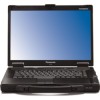Panasonic Toughbook 52 Mapping Technical and Operational Challenges of Mobile - Page 4
Ii. The Evolution Of Rugged Mobile Computing - specifications
 |
View all Panasonic Toughbook 52 manuals
Add to My Manuals
Save this manual to your list of manuals |
Page 4 highlights
VDC's TCO analysis of mobile computing deployments demonstrates that there is a correlation between increasing ruggedness and decreased cost over the life of the deployment where there are hazards within the deployment environment that can cause failure. VDC's TCO analysis of mobile computing deployments demonstrates that there is a correlation between increasing ruggedness and decreased cost over the life of the deployment where there are hazards within the deployment environment that can cause failure. In order to make appropriate investment decisions, organizations should map device specifications to the potential hazards in the deployment environment. Conditions as diverse as in-vehicle vibration and exposure to extreme temperatures and/or humidity, to the drops and spills experience by frequent travelers, all influence the performance of mobile investments in the field. One frequently overlooked yet essential step in the mobile computing solution evaluation process is segmenting target users by usage environment and job requirements and prescribing the best possible mobile computing solution to fit their needs. It is imperative to balance the user, application, deployment environment and-perhaps most importantly-the mission criticality of the applications. II. THE EVOLUTION OF RUGGED MOBILE COMPUTING Use of mobile computing continues to extend beyond basic e-mail and PIMS application to more integral business applications that can significantly heighten operational efficiencies. VDC estimates the total number of mobile workers to have reached 80 million in the United States in 2008. This increasingly mobile workforce heightens the need for effective and appropriate mobile computing and communications solutions. Consider, for instance, mobile solutions that, through real time connectivity, allow Direct Store Delivery operations to redirect trucks to fulfill same-day orders. Sealed mobile solutions that can be disinfected for use in a laboratory permit researchers to directly enter data into the computer system, eliminating the paper-to-computer data chain. Mobile CRM platforms let field sales agents access vastly more information than they were ever able to carry on paper into their clients. Mobile computing extends the enterprise, allowing end users to achieve new levels of efficiency and accuracy in their work. Because mobile solutions have become deeply etched into the operations of the mobile workforce, a failed device has a direct effect on worker productivity, customer service, and, ultimately, revenue. This increasing importance of mobility has impacted investment philosophies, driving a new model of how we think about computers, environments, and operators. A significant development to meet the emerging needs of today's mobile workers has been the evolution of rugged mobile computing and emergence of various classes of ruggedness or durability depending on a user's needs. Once associated with high adoption costs, significant bulk and weight and lagging several generations behind in terms of computing performance, these solutions have evolved considerably. © 2009 VDC Research Group, Inc. 3













